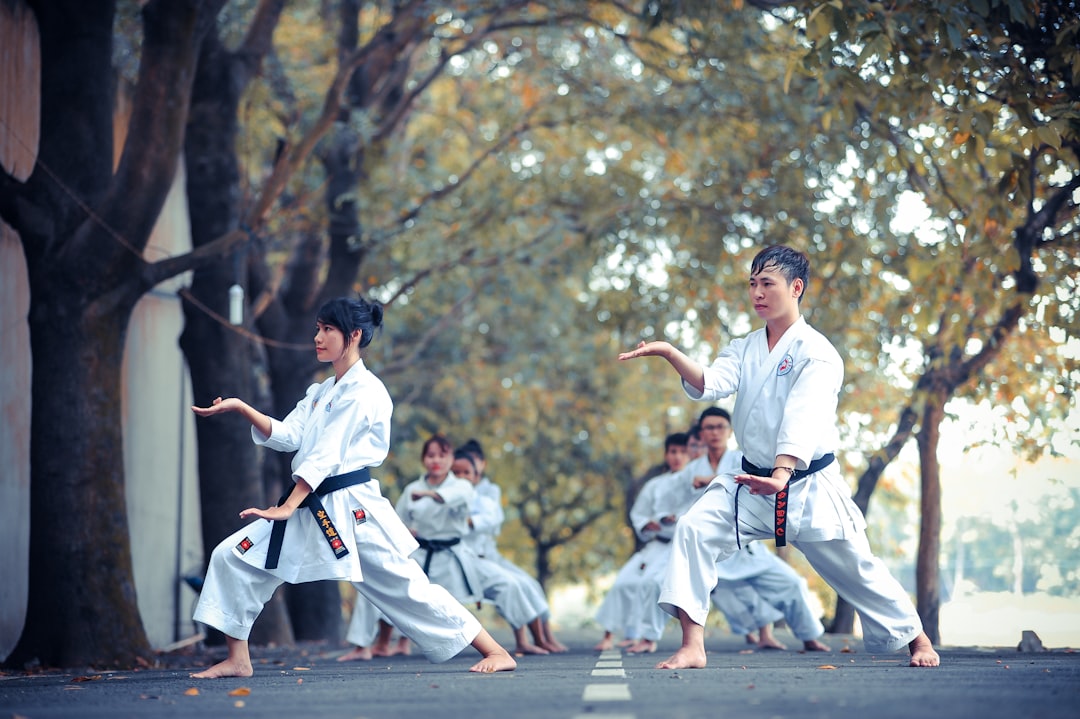The discussion focuses on the karate uniform, known as a gi, which is central to the practice of karate for both practical and symbolic reasons. The traditional white gi represents purity and cleanliness and is worn by practitioners to signify their dedication and rank within the martial arts community. A standard gi includes a jacket with long or short sleeves, hemmed trousers, and a belt, known as an obi. While the white color is customary, different colors indicate varying ranks or school affiliations, with black gis often reserved for higher-ranking practitioners. The proper term for this attire is a "gi," which is essential in the discipline of karate, symbolizing respect and tradition. The choice of materials is crucial for comfort and durability during rigorous training, and the design of the gi ensures optimal range of motion while maintaining the classic aesthetic. Although modern karate gis have adapted to meet the needs of practitioners, they still differ from those used in other martial arts, with the International Karate Federation regulating their specifications for competitions. The traditional uniform's name, karate uniform name, upholds a reverence for tradition while also accommodating contemporary training and competitive standards.
black belt aficionados and martial arts enthusiasts alike recognize the significance of a well-tailored karate uniform, commonly referred to as a gi. This article delves into the intricacies of what constitutes a proper karate uniform, from its historical origins to the specifics of its design and materials. We will explore the essential role a gi plays in the practice of karate, dissect its components for an understanding of their significance, and trace its evolution through time. Join us as we uncover the karate uniform name and its place within the traditions that continue to shape this dynamic discipline.
- Understanding the Essentials of a Karate Uniform: The Gi's Role and Significance
- Breaking Down the Karate Uniform: Components, Materials, and Cuts
- Tradition and Evolving Standards: The History and Variations of Karate Gis
Understanding the Essentials of a Karate Uniform: The Gi's Role and Significance

When engaging in karate, the practitioner wears a uniform known as a gi. This garment is central to the practice, serving both functional and symbolic purposes. The gi, a traditional martial arts attire, is composed of a jacket, trousers, and a belt, which collectively represent the student’s commitment and rank within the discipline. What is the proper name of a karate uniform? A karate uniform is accurately called a “gi.” The top half of the gi, a jacket with long or short sleeves, is designed to facilitate a full range of motion, allowing for unrestricted movement during practice and sparring. The trousers, which are often hemmed to fall just above the ankle, provide flexibility and comfort for various stances and techniques. Are there specific color codes associated with karate uniforms? Typically, white is the most common color for a karate gi, symbolizing purity and cleanliness both in spirit and in practice. It’s also worth noting that different colors can represent different ranks or schools within the martial arts community. For instance, black gis are often worn by higher-ranking belts, while colored belts may be accompanied by gis of different hues to signify the wearer’s progress and achievements in karate.
Breaking Down the Karate Uniform: Components, Materials, and Cuts

When practitioners step onto the mats, they don their traditional karate uniform, commonly referred to as a “gi” or “keikogi.” This garment is designed for both practicality and respect within the martial arts community. The gi typically consists of a jacket, trousers, and a belt, known as an “obi,” which denotes the wearer’s rank. The jacket, or “uju,” is usually buttoned up the front and has long sleeves that can be rolled up during practice. It is traditionally made from heavy cotton or hemp fabric to provide durability during techniques that involve striking or grappling. The trousers, called “rei-gi,” are wide-legged and also constructed from a sturdy material, offering mobility while maintaining a traditional silhouette. Both the jacket and trousers are typically white, symbolizing purity and humility within the martial arts discipline. What materials are used in a karate uniform, and how do they contribute to the practitioner’s performance? The choice of materials in a gi is crucial; they need to be breathable yet sturdy enough to withstand the rigors of training. Heavy cotton or hemp offers a good balance, allowing for a cool training environment while resisting wear and tear. Additionally, the cuts of the jacket and trousers are tailored to allow for a full range of motion, enabling practitioners to execute techniques with ease without compromising on the traditional aesthetic of the uniform.
Tradition and Evolving Standards: The History and Variations of Karate Gis

Karate practitioners around the world don black garments known as “Gis” during training and competitions, a tradition deeply rooted in the martial art’s history. The origins of the Gi can be traced back to ancient Japan, where similar attire was used in various martial arts to allow for ease of movement and to facilitate the observation of technique. Over time, the Karate Gi has evolved slightly from its traditional counterpart used in disciplines like Judo and Kendo, adapting to the specific needs of karateka. Today, the International Karate Federation has established specifications for competitive Karate Gis, ensuring they are consistent and do not hinder performance. These standards dictate aspects such as color, fabric, and design, influencing how modern Karate Gis look and feel compared to early designs.
The traditional Karate Gi consists of a jacket, trousers, and belt, known as the Obi. The Jacket, or Uwagi, is typically fastened with three or four rings on each shoulder for the Obi, and it is usually made from heavier cotton or hemp fabric called “Kasumi” to provide durability while training. The trousers, or Shin-gi, are straight-legged and often have reinforced knees for protection during practice. While the specifications of a Karate Gi can vary between dojos and organizations, they all serve the purpose of providing a standardized uniform that respects the tradition of the martial art while accommodating the evolving standards of competition and training. What remains constant is the essence of the Gi as a symbol of humility and respect for the practice of Karate.
In conclusion, the karate uniform, commonly known as a gi, serves not only as a garment for practitioners but also as a symbol of tradition and discipline within the martial art. A deep dive into its components, materials, and cuts reveals the meticulous attention to detail that contributes to both the functionality and respect associated with the practice of karate. From the origins of the white gi to contemporary variations, the evolution of this uniform reflects the dynamic nature of karate itself. Understanding the essentials of a karate uniform, as discussed, is key for anyone looking to engage in this martial art authentically. Whether for competition, training, or grading, the karate uniform name remains a cornerstone of the karate experience, honoring both the past and the future of this venerable discipline.
